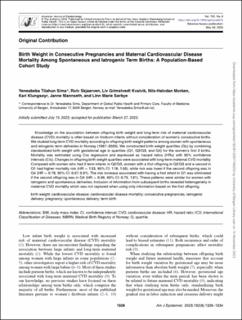Birth Weight in Consecutive Pregnancies and Maternal Cardiovascular Disease Mortality Among Spontaneous and Iatrogenic Term Births: A Population-Based Cohort Study
Sima, Yeneabeba Tilahun; Skjaerven, Rolv; Kvalvik, Liv Grimstvedt; Morken, Nils-Halvdan; Klungsøyr, Kari; Mannseth, Janne; Sørbye, Linn Marie
Journal article, Peer reviewed
Published version

Åpne
Permanent lenke
https://hdl.handle.net/11250/3116425Utgivelsesdato
2023Metadata
Vis full innførselSamlinger
Sammendrag
Knowledge on the association between offspring birth weight and long-term risk of maternal cardiovascular disease (CVD) mortality is often based on firstborn infants without consideration of women’s consecutive births. We studied long-term CVD mortality according to offspring birth weight patterns among women with spontaneous and iatrogenic term deliveries in Norway (1967–2020). We constructed birth weight quartiles (Qs) by combining standardized birth weight with gestational age in quartiles (Q1, Q2/Q3, and Q4) for the women’s first 2 births. Mortality was estimated using Cox regression and expressed as hazard ratios (HRs) with 95% confidence intervals (CIs). Changes in offspring birth weight quartiles were associated with long-term maternal CVD mortality. Compared with women who had 2 term infants in Q2/Q3, women with a first offspring in Q2/Q3 and a second in Q1 had higher mortality risk (HR = 1.33, 95% CI: 1.18, 1.50), while risk was lower if the second offspring was in Q4 (HR = 0.78, 95% CI: 0.67, 0.91). The risk increase associated with having a first infant in Q1 was eliminated if the second offspring was in Q4 (HR = 0.99, 95% CI: 0.75, 1.31). These patterns were similar for women with iatrogenic and spontaneous deliveries. Inclusion of information from subsequent births revealed heterogeneity in maternal CVD mortality which was not captured when using only information based on the first offspring.
